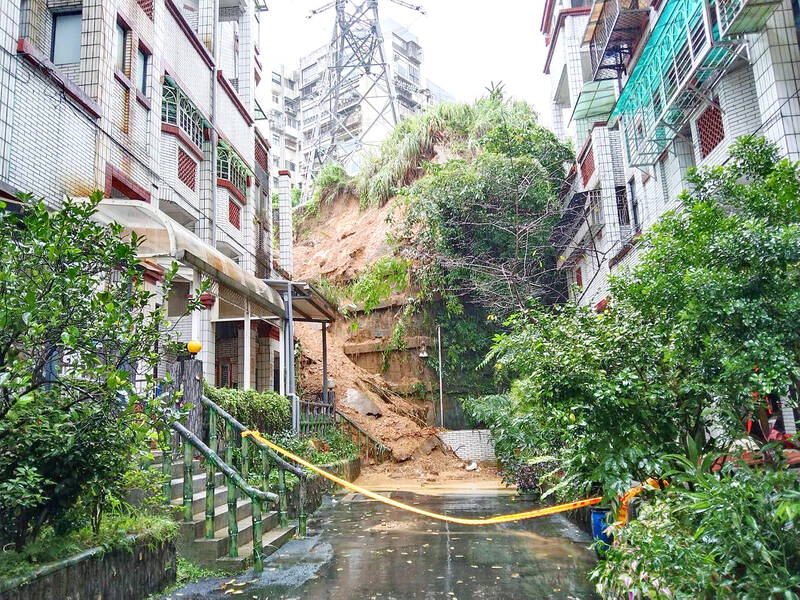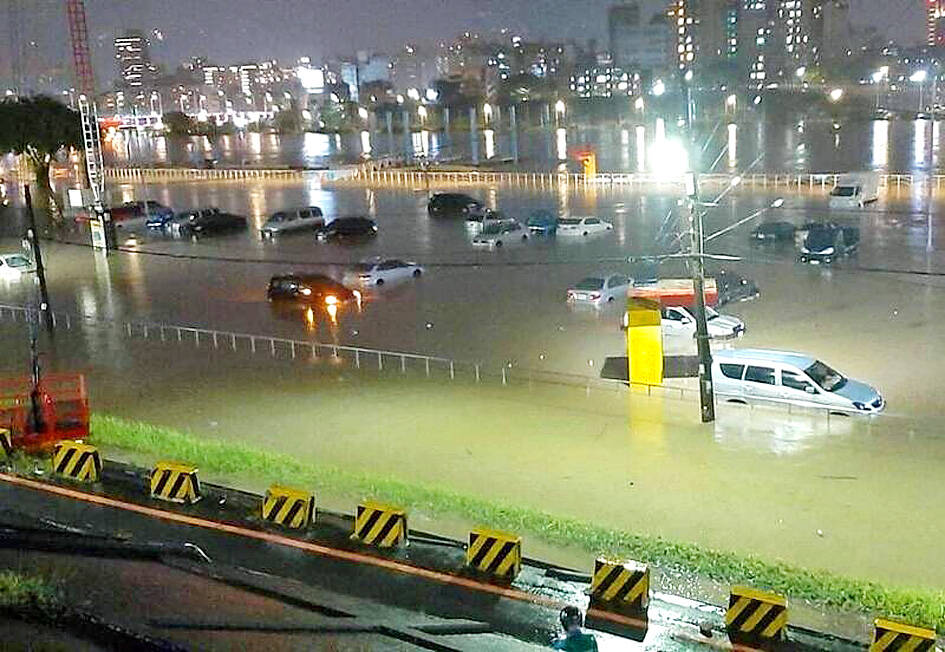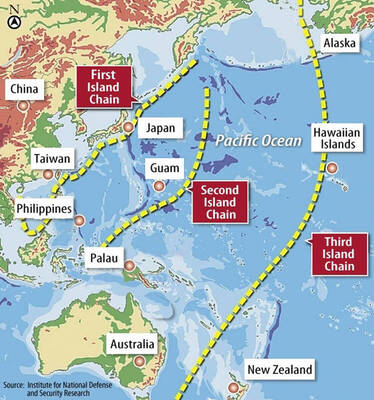More than 500 cases of damage to public infrastructure and private property had been reported as Tropical Storm Nesat moved away from Taiwan yesterday after causing destruction nationwide.
After the downpours drenched northern and eastern Taiwan over the past two days, 509 cases of destruction to roads and facilities, including 244 in Taipei and 145 in New Taipei City, were reported across the nation as of 3pm yesterday, the National Fire Agency said.
In New Taipei City, 70 people in a residential community in Sijhih District (汐止), where heavy rain on Sunday night triggered a mudslide, were all safe and waiting to be evacuated, officials said.

Photo: Tien Yu-hua, Taipei Times
Earlier yesterday morning, a total of 297 motorists and passengers trapped on Provincial Highway 7 in Yilan County since the previous night were rescued, the emergency operation center said, adding that some of them were taken to the Chilan Resort in Datong Township (大同).
Traffic on two sections of national highways — the 114.6k to 167.1k mark on Provincial Highway 8 and the 25k to 44k mark on the Southern Cross-Country Highway — were partially resumed later yesterday and is scheduled to fully reopen tomorrow morning, the Directorate-General of Highways said.
Repairs on four damaged sections of provincial highways in Taoyuan, Yilan and Taitung counties were being made and traffic is expected to return to normal today, authorities added.

Photo by Cheng Ming-hsiang, Taipei Times
In Taipei, more than 100 vehicles were stuck in floodwater in a parking lot outside floodgates near the Bailing Bridge (百齡橋), and a “yellow” landslide warning was issued in some areas.
Many car owners said the city government sent a notice too late for them to move their vehicles.
To avoid a recurrence, Taipei Mayor Ko Wen-je (柯文哲) called for enhanced cooperation with the central government to establish a better early warning system, improving the messaging system to notify drivers whose vehicles are parked outside floodgates and allocating a budget to integrate the emergency operation center and the big data center.
“However, the government is only responsible for notifying vehicle owners. Each citizen should take responsibility for their own behavior [on whether they move their vehicle after receiving a notification],” he said.
The Central Weather Bureau said that chances of extremely heavy rain or heavy rain triggered by the storm’s outer ring are high in regions north of Taoyuan and the northeastern parts of the country, warning that precipitation and gusty winds could continue in those areas today.
With the current seasonal northeasterly wind system gathering strength, daytime temperatures in northern Taiwan are expected to dip to as low as 17oC today, it added.
Northern Taiwan is expected to feel the most apparent pinch resulting from the wind effects, and temperature highs are forecast to range between 18oC and 19oC, with some open areas likely to see the mercury fall to 17oC today, it said.
Elsewhere in Taiwan, warmer weather is possible, with daytime temperatures forecast to range between 20oC and 21oC, it said.
Former bureau Weather Forecast Center director Daniel Wu (吳德榮), an adjunct associate professor of atmospheric sciences at National Central University, added that the weather conditions were expected to improve from tomorrow, while it would stay cool in the early hours of the morning.
The mercury is expected to start recovering from Thursday, but a wide daytime-nighttime temperature gap is possible, he said.

The US government has signed defense cooperation agreements with Japan and the Philippines to boost the deterrence capabilities of countries in the first island chain, a report by the National Security Bureau (NSB) showed. The main countries on the first island chain include the two nations and Taiwan. The bureau is to present the report at a meeting of the legislature’s Foreign Affairs and National Defense Committee tomorrow. The US military has deployed Typhon missile systems to Japan’s Yamaguchi Prefecture and Zambales province in the Philippines during their joint military exercises. It has also installed NMESIS anti-ship systems in Japan’s Okinawa

‘WIN-WIN’: The Philippines, and central and eastern European countries are important potential drone cooperation partners, Minister of Foreign Affairs Lin Chia-lung said Minister of Foreign Affairs Lin Chia-lung (林佳龍) in an interview published yesterday confirmed that there are joint ventures between Taiwan and Poland in the drone industry. Lin made the remark in an exclusive interview with the Chinese-language Liberty Times (the Taipei Times’ sister paper). The government-backed Taiwan Excellence Drone International Business Opportunities Alliance and the Polish Chamber of Unmanned Systems on Wednesday last week signed a memorandum of understanding in Poland to develop a “non-China” supply chain for drones and work together on key technologies. Asked if Taiwan prioritized Poland among central and eastern European countries in drone collaboration, Lin

Renewed border fighting between Thailand and Cambodia showed no signs of abating yesterday, leaving hundreds of thousands of displaced people in both countries living in strained conditions as more flooded into temporary shelters. Reporters on the Thai side of the border heard sounds of outgoing, indirect fire yesterday. About 400,000 people have been evacuated from affected areas in Thailand and about 700 schools closed while fighting was ongoing in four border provinces, said Thai Rear Admiral Surasant Kongsiri, a spokesman for the military. Cambodia evacuated more than 127,000 villagers and closed hundreds of schools, the Thai Ministry of Defense said. Thailand’s military announced that

CABINET APPROVAL: People seeking assisted reproduction must be assessed to determine whether they would be adequate parents, the planned changes say Proposed amendments to the Assisted Reproduction Act (人工生殖法) advanced yesterday by the Executive Yuan would grant married lesbian couples and single women access to legal assisted reproductive services. The proposed revisions are “based on the fundamental principle of respecting women’s reproductive autonomy,” Cabinet spokesperson Michelle Lee (李慧芝) quoted Vice Premier Cheng Li-chiun (鄭麗君), who presided over a Cabinet meeting earlier yesterday, as saying at the briefing. The draft amendment would be submitted to the legislature for review. The Ministry of Health and Welfare, which proposed the amendments, said that experts on children’s rights, gender equality, law and medicine attended cross-disciplinary meetings, adding that